

Pretty much every cell in the body of a life form has the same DNA. Genes are bits of this DNA that code for proteins or (less commonly) other huge biomolecules. A gene is communicated through a two-step procedure wherein the geneís DNA is first deciphered into RNA, which is then converted into the corresponding protein. An epic innovation of gene-expression microarraysñ whose advancement began in the second half of the 1990ís and is revolutionarily affecting molecular biology and permits one to screen the DNA-to-RNA part of this major biological procedure. For what reason should this new improvement in biology interest researchers in AI and different areas of artificial intelligence?
While the ability to gauge transcription of a single gene isn't new, the ability to quantify without a moment's delay the transcription of the considerable number of genes in a living being is new. Thus, the amount of data that biologists need to analyze is overpowering. A significant number of the data sets we portray right now of around 100 samples, where each sample contains around 10,000 genes estimated on a gene-expression microarray.
Assume 50 of these patients have one disease, and the other 50 have an alternate malady. Discovering a blend of genes whose expression levels can recognize these two groups of patients is an overwhelming task for a human, yet a moderately natural one for a machine-learning algorithm. Obviously, this example additionally shows a challenge that microarray data poses for machine-learning algorithms and the dimensionality of the data is high compared with the common number of data points.
Machine learning algorithms, for example, are helping biologists understand the bewildering number of molecular signs that control how genes work. In any case, as new algorithms are created to analyze much more information, they likewise become progressively mind boggling and increasingly hard to decipher. Quantitative biologists Justin B. Kinney and Ammar Tareen have a system to design advanced machine learning algorithms that are simpler for biologists to comprehend.
The algorithms are a kind of artificial neural network (ANN). Roused by the manner in which neurons interface and branch in the brain, ANNs are the computational foundations for cutting edge machine learning. Also, in spite of their name, ANNs are not solely used to contemplate minds.
Scholars, as Tareen and Kinney, use ANNs to analyze information from an exploratory method called a "massively parallel reporter assay" (MPRA) which researches DNA. Utilizing this information, quantitative biologists can make ANNs that anticipate which molecules control explicit genes in a procedure called gene regulation.
Machine learning has a lot to offer to the progressive new innovation of gene microarrays. From microarray design itself to essential biology to medication, researchers have employed machine learning to make gene chips progressively handy and valuable. Gene chips have just changed the field of science. Information that may have taken a long time to gather presently takes seven days.
Biologists are helped enormously by the supervised and unsupervised learning techniques that many are utilizing to comprehend the huge amount of data now accessible to them, and extra challenging learning tasks will keep on emerging as the field further develops. Thus, we have seen a fast increment in the rate at which biologists can comprehend the molecular processes that underlie and oversee the function of biological systems.
Cells needn't proteins constantly. Rather, they depend on complex molecular mechanisms to turn the genes that produce proteins on or off, varying. At the point when those guidelines come up short, disorder and disease usually follow.
"That mechanistic knowledge, seeing how something like gene regulation works, is all the time the difference between having the option to create molecular therapies against diseases and not having the option to," Kinney said.
Lamentably the way standard ANNs are formed from MPRA information is altogether different from how researchers pose questions in the life sciences. This misalignment implies that biologists think that it's hard to decipher how gene regulation occurs.
Kinney and Tareen built up another methodology that conquers any hindrance between computational tools and how biologists think. They made custom ANNs that numerically reflect basic ideas in biology concerning genes and the molecules that control them. Right now, pairs are basically driving their machine learning algorithms to process data such that a biologist can comprehend.
As our huge amount of genomic and comparative sorts of information keeps on developing, the role of computational methods, particularly machine learning, will develop with it. These algorithms will empower us to deal with the task of analyzing this information to yield important insight into the biological systems that encompass us and the diseases that affect us.
Join our WhatsApp Channel to get the latest news, exclusives and videos on WhatsApp
_____________
Disclaimer: Analytics Insight does not provide financial advice or guidance on cryptocurrencies and stocks. Also note that the cryptocurrencies mentioned/listed on the website could potentially be scams, i.e. designed to induce you to invest financial resources that may be lost forever and not be recoverable once investments are made. This article is provided for informational purposes and does not constitute investment advice. You are responsible for conducting your own research (DYOR) before making any investments. Read more here.
